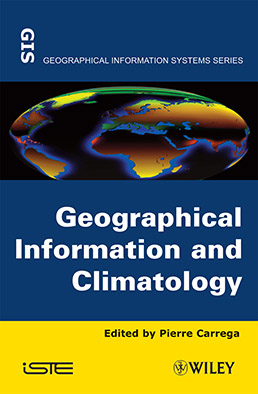
Climate data (as well as conclusions or predictions drawn from it) and geographical information cannot truly be considered separately from one another since geography is both a source of data and a spatial structure that has to be examined and interpreted. This book analyzes the relationships between geographical information and climate data that can be obtained from meteorological station networks on the ground, or from remote sensing data.
The production of climatological and meteorological physical models needs a complete, detailed description of the Earth’s surface that interacts with the atmosphere. Similarly, a statistical approach that aims to interpolate and reconstruct a temperature or rainfall distribution with instantaneous or average values will need to be based on geographical information. In either case, the approach will be different depending on which technique is used, and based on spatial autocorrelation or environmental regression. In the field of risk, this logic can also be applied to composite variables, such as meteorological risk indices.
This book is divided into two parts. The first part takes a theoretical and introductory approach, covering fundamental principles: geospatial climate data measurement; spatial analysis, mapping and climate; geographical information, remote sensing and climatology; and geographical information for initializing forecasting and climate models. The second part describes geographical information used in various important climate applications, related to risk: urban climate; air pollution; hydrological problems linked to climatology; forest fires.
From these approaches it is clear that geographical information is essential for climate study. It cannot be reduced to a simple application of Geographical Information Systems (GIS), nor can it be seen as an inert and neutral tool independent of its historic origin. This book provides the information and means of application to enable the reader to successfully utilize both climate and GIS data in the study and understanding of either.
1. Basics of Climatological and Meteorological Observations for GIS Applications, Wolfgang Schoener.
2. Spatial Analysis, Cartography, and Climate, Daniel Joly.
3. Geographical Information, Remote Sensing, and Climatology, Vincent Dubreuil.
4. Geographical Information for the Initialization of Numerical Weather Forecast Models and Climate Modeling, Pierre Bessemoulin.
5. Assessing and Modeling the Urban Climate in Lisbon, Maria João Alcoforado.
6. Geographic Information, Climate, and Atmospheric Pollution, Isabelle Roussel.
7. Geographical Information and Climatology for Hydrology, Jean-Pierre Laborde.
8. Geographic Information, Climatology, and Forest Fires, Pierre Carrega.
Pierre Carrega is Professor of Physical Geography at the University of Nice-Sophia Antipolis in France. As a climatologist, he works at the topoclimatological scale (local) on mapping logic in particular, specializing in climatic implications of risk management: forest fires, air pollution and urban climates.